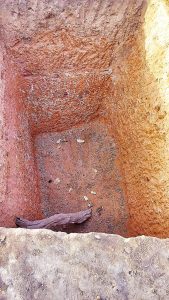This project has been completed under the direction of Peace Corps Volunteer Nathan Rehr.
 To read about the beginning of the project, CLICK HERE.
To read about the beginning of the project, CLICK HERE.
The following is Nathan’s conclusion report:
This project was designed to improve the access to clean water and sanitary facilities at the community-operated health facility in Sare Gueladio. We set out to accomplish this by installing a faucet that is connected to a nearby forage to provide a convenient source of water for drinking and cleaning at the health facility. We also wanted to install an improved, ventilated latrine for use by patients and volunteers at the health facility.
The faucet was installed by connecting an auxiliary pipe to the main line that connected the forage to the existing faucets in the village. The main line stretches about 1 kilometer while our auxiliary line measures about 100 meters. Men from the village volunteered to dig the 100-meter trench as a contribution to the project. After the trench was completed, we called a plumber from the Senegalese Department of Water (SDE) to install the piping and faucet. Work on this portion of the project progressed very quickly given the full-service nature of working with SDE. The plumber brought all of his own materials and was able to complete the installation in one day. The faucet was installed and operational by mid-December. It has its own meter to monitor consumption and the health volunteers who operate the health hut have a plan to pay for the water with money raised from medicine sales.
As work progressed for the faucet, we also identified the location for the latrine and began digging. This posed the greatest delays and unforeseen costs as the chosen location was very rocky and was dug at a high cost, rather than as part of the community’s in-kind contribution.
After the pit for the septic tank was dug, (2 meters deep, 1.5×2 meters across), we began collecting money from villagers in the areas served by the facility. Each house was asked to contribute 250 Francs CFA, a very affordable amount. Masons were hired for brick making and then the construction of a brick and cement-lined, aerated, septic tank. The final step was installing the toilet seat.
Now, the health facility has a functioning latrine and faucet. At the most recent prenatal visits at the facility, women were very happy to have a convenient source of drinking water and since the installation, feedback has been exclusively positive. It remains to be seen how significant the impact will be on increasing the number of patients willing to seek care at the health facility but in general, the opinion of the health hut has improved among the communities served.
We would like to thank Nathan once again for executing such a fine project.





